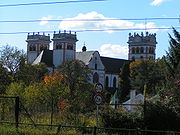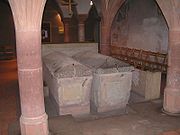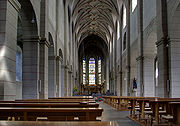
St. Matthias' Abbey, Trier
Encyclopedia


Trier
Trier, historically called in English Treves is a city in Germany on the banks of the Moselle. It is the oldest city in Germany, founded in or before 16 BC....
, Rhineland-Palatinate
Rhineland-Palatinate
Rhineland-Palatinate is one of the 16 states of the Federal Republic of Germany. It has an area of and about four million inhabitants. The capital is Mainz. English speakers also commonly refer to the state by its German name, Rheinland-Pfalz ....
, Germany
Germany
Germany , officially the Federal Republic of Germany , is a federal parliamentary republic in Europe. The country consists of 16 states while the capital and largest city is Berlin. Germany covers an area of 357,021 km2 and has a largely temperate seasonal climate...
.
The abbey church, a Romanesque
Romanesque architecture
Romanesque architecture is an architectural style of Medieval Europe characterised by semi-circular arches. There is no consensus for the beginning date of the Romanesque architecture, with proposals ranging from the 6th to the 10th century. It developed in the 12th century into the Gothic style,...
basilica
Basilica
The Latin word basilica , was originally used to describe a Roman public building, usually located in the forum of a Roman town. Public basilicas began to appear in Hellenistic cities in the 2nd century BC.The term was also applied to buildings used for religious purposes...
, is a renowned place of pilgrimage
Pilgrimage
A pilgrimage is a journey or search of great moral or spiritual significance. Typically, it is a journey to a shrine or other location of importance to a person's beliefs and faith...
because of the tomb of Saint Matthias the Apostle
Saint Matthias
Matthias , according to the Acts of the Apostles, was the apostle chosen by the remaining eleven apostles to replace Judas Iscariot following Judas' betrayal of Jesus and his suicide.-Biography:...
, after whom the abbey is named, located here since the 12th century, and the only burial of an apostle in Germany and north of the Alps
Alps
The Alps is one of the great mountain range systems of Europe, stretching from Austria and Slovenia in the east through Italy, Switzerland, Liechtenstein and Germany to France in the west....
. The abbey was originally named after Saint Eucharius
Eucharius
Saint Eucharius is venerated as the first bishop of Trier. He lived in the second half of the third century. According to an ancient legend, he was one of the seventy-two disciples of Christ, and was sent to Gaul by Saint Peter as bishop, together with the deacon Valerius and the subdeacon...
, first Bishop of Trier, whose tomb is in the crypt
Crypt
In architecture, a crypt is a stone chamber or vault beneath the floor of a burial vault possibly containing sarcophagi, coffins or relics....
. The church has been given the status of a basilica minor.
First foundation

Since the 10th century the bones of the founders of the Archbishopric of Trier
Archbishopric of Trier
The Archbishopric of Trier was a Roman Catholic diocese in Germany, that existed from Carolingian times until the end of the Holy Roman Empire. Its suffragans were the dioceses of Metz, Toul and Verdun. Since the 9th century the Archbishops of Trier were simultaneously princes and since the 11th...
, bishops Eucharius and Valerius, have been preserved here.

Roman Emperor
The Roman emperor was the ruler of the Roman State during the imperial period . The Romans had no single term for the office although at any given time, a given title was associated with the emperor...
Constantine I
Constantine I
Constantine the Great , also known as Constantine I or Saint Constantine, was Roman Emperor from 306 to 337. Well known for being the first Roman emperor to convert to Christianity, Constantine and co-Emperor Licinius issued the Edict of Milan in 313, which proclaimed religious tolerance of all...
, but the relics were only discovered in 1127 during demolition work on the predecessor of the present church buildings, since which time the abbey has been a major centre of pilgrimage.
Efforts to reform in the wake of the Council of Basle, under Johannes Rode, the Carthusian
Carthusian
The Carthusian Order, also called the Order of St. Bruno, is a Roman Catholic religious order of enclosed monastics. The order was founded by Saint Bruno of Cologne in 1084 and includes both monks and nuns...
prior appointed by the bishop, led to spiritual and economic renewal, to the extent that St. Matthias' became an example for other monasteries. The attempt to found a congregation round it came to nothing, however, and St. Matthias' in due course joined the Bursfelde Congregation
Bursfelde Congregation
The Bursfelde Congregation, also called Bursfelde Union, was a union of predominantly west and central German Benedictine monasteries and nunneries working for the reform of Benedictine practice. It was named after Bursfelde Abbey.-Background:...
in 1458.
The abbey passed through the Reformation
Protestant Reformation
The Protestant Reformation was a 16th-century split within Western Christianity initiated by Martin Luther, John Calvin and other early Protestants. The efforts of the self-described "reformers", who objected to the doctrines, rituals and ecclesiastical structure of the Roman Catholic Church, led...
almost unscathed, but it was badly affected by wars and looting, and also by conflicts with various bishops or abbots. The last abbot was relieved of his office as early as 1783, years before the actual dissolution of the abbey, and management from then on lay in the hands of the prior.

French Revolution
The French Revolution , sometimes distinguished as the 'Great French Revolution' , was a period of radical social and political upheaval in France and Europe. The absolute monarchy that had ruled France for centuries collapsed in three years...
spilled over onto German territory, the abbey buildings were requisitioned by the French army, and monks were obliged to leave the abbey, at first with the intention that this was to be a temporary absence, living from 1794 to 1802 in the parish house (Mattheiser Pfarrhaus). In 1802 however the abbey was nationalised and secularised. When the premises were sold off, the local businessman Christoph Philipp Nell acquired the bulk of the main building complex and used it with little alteration for his residence, thus preserving it from the demolition and gross alterations for industrial purposes that befell many other monastic buildings at this period.
Apart from the main abbey complex there remain, particularly in villages along the Moselle
Moselle
Moselle is a department in the east of France named after the river Moselle.- History :Moselle is one of the original 83 departments created during the French Revolution on March 4, 1790...
, many farmhouses and estate buildings which formed the abbey's economic basis before secularisation. They are often called "Mattheiser Hof" ("Matthias' farm") or other names making reference to the abbey. An especially large farm of this sort was the Roscheider Hof near the village of Merzlich (now Konz-Karthaus), now the Volkskunde- und Freilichtmuseum Roscheider Hof ("Local History and Open-air Museum, Roscheider Hof"), where the original building is preserved as one of the exhibits.
Second foundation

Seckau Abbey
Seckau Abbey or Abbey of Our Dear Lady, Seckau is a Benedictine monastery in Seckau in Styria, Austria.-Seckau Priory:The monastery was founded by the Augustinian Canons, when an already existing community in Sankt Marein bei Knittelfeld was moved to Seckau in 1142...
, part of the Beuron Congregation, moved into the Mattheiser Pfarrhaus after World War I
World War I
World War I , which was predominantly called the World War or the Great War from its occurrence until 1939, and the First World War or World War I thereafter, was a major war centred in Europe that began on 28 July 1914 and lasted until 11 November 1918...
. On 22 October 1922 the main building complex was rededicated as a Benedictine abbey and resettled. The new community joined the Beuron Congregation.
In 1941 the National Socialist government suspended the monastery and the monks moved to Maria Laach Abbey
Maria Laach Abbey
Maria Laach Abbey is a Benedictine abbey situated on the southwestern shore of the Laacher See , near Andernach, in the Eifel region of the Rhineland-Palatinate in Germany. It is a member of the Beuronese Congregation within the Benedictine Confederation...
. After their return in 1945 there was dissension over the care of the parish of St. Matthias, which was now independent of the Benedictine order, for whom parochial duties with the secure income they provided represented a staple economic resource. It was recommended that the monastic community should move to Tholey Abbey
Tholey Abbey
Tholey Abbey in Tholey, in the district of Sankt Wendel in Saarland, is a Benedictine monastery dedicated to Saint Maurice. It is part of the Beuronese Congregation within the Benedictine Confederation.-History:...
in the Saarland
Saarland
Saarland is one of the sixteen states of Germany. The capital is Saarbrücken. It has an area of 2570 km² and 1,045,000 inhabitants. In both area and population, it is the smallest state in Germany other than the city-states...
, a move which split the community between those who were willing to go to Tholey, and those who preferred to stay in Trier. Those monks who remained in St. Matthias' became independent of any congregation, and remained so until 1981, when they joined the Congregation of the Annunciation of the Blessed Virgin Mary ("Congregatio Annuntiationis BMV").
Since 1991 the abbey has had a close link with Huysburg Priory in Saxony-Anhalt
Saxony-Anhalt
Saxony-Anhalt is a landlocked state of Germany. Its capital is Magdeburg and it is surrounded by the German states of Lower Saxony, Brandenburg, Saxony, and Thuringia.Saxony-Anhalt covers an area of...
, refounded in 1972. In September 2004 the two monasteries joined as one community.
The community devotes itself to the cure of souls - in 2007 10,000 Roman Catholics belonged to the parish of St. Matthias - as well as hospital and pilgrimage duties. The community also receives guests and leads ecumenical discussions. Individual brothers may also pursue secular occupations, such as judge, town planner or teacher.
From 1981 to 2005 Dom Ansgar Schmidt led the community as its abbot until his election as President-Abbot of the Congregation. Ignatius Maaß was elected his successor, and nominated Matthias Vogt as his new prior; the benediction took place on 22 October 2005.
As of 2007 19 monks lived in the abbey.
Basilica

The basilica has therefore been thoroughly transformed during a long-drawn-out exercise in cleaning up and alteration. The crypt has been extended by a further two bays and provided with new means of access. The place of the veneration of Saint Matthias the Apostle, as well as the altar space, have been adapted to modern requirements. Stable choir stalls have been built for the monks' choir. A lift has been installed for easier access to all levels. On 10 December 2007 during a solemn pontifical office with Bishop Reinhard Marx
Reinhard Marx
Reinhard Marx is a German Cardinal of the Roman Catholic Church. He currently serves as the incumbent Cardinal archbishop of Munich and Freising. Pope Benedict XVI elevated Cardinal Marx to the cardinalate in a consistory on 20 November 2010...
the bones of the Apostle Matthias in their shrine were translated to their final location in the crypt, with the solemn dedication of the altar planned for 24 February 2008. The conclusion of the building works with an overhaul of the electrics and a final paint job is not presently possible due to financial constraints.
Reliquary of the Cross
In the Chapel of the Cross (Kreuzkapelle) in the north side-tower of the basilica is kept the reliquaryReliquary
A reliquary is a container for relics. These may be the physical remains of saints, such as bones, pieces of clothing, or some object associated with saints or other religious figures...
of the cross, or "staurotheca". It dates from the 13th century and is made of worked gold; in the centre is a golden cross set with precious stones, which is said to contain pieces of the True Cross
True Cross
The True Cross is the name for physical remnants which, by a Christian tradition, are believed to be from the cross upon which Jesus was crucified.According to post-Nicene historians, Socrates Scholasticus and others, the Empress Helena The True Cross is the name for physical remnants which, by a...
. The Chapel of the Cross is accessible on guided tours.
Abbots (incomplete list)
- 1211–1257: Jakob of Lorraine
- 1416–1421: Herbrand von Guls
- 1421–1439: Johannes Rode
- 1439–1447: Johannes von Vorst
- 1447–1451: Heinrich Wolff von Sponheim
- 1451–: Johannes Donre
- 1569–1573: Peter von Niederweiß
- 1599–1612: Johann von Keil
- 1629–1649: Nikolaus Trinkler
- 1700–1727: Wilhelm Henn
- 1727–1758: Modestus Manheim
- 1758–1773: Adalbert Wiltz
After the refoundation:
- 1922–1938: Laurentius Zeller (elected President of the Brazilian Congregation 1938)
- 1939–1946: Basilius Ebel (1946–1966 Abbot of Maria Laach Abbey)
- 1947–1949: Petrus Borne (1949–1976 Abbot of Tholey Abbey)
The community split in 1949: one part resettled in Tholey with Abbot Petrus Borne; the remainder in Trier belonged to no congregation and was directly subordinate to the Abbot-Primate of the Benedictine Order.
- 1963–1969: Laurentius Klein
- 1969–1981: Athanasius Polag
- 1981–2005: Ansgar Schmidt (since 2004 President of the Congregation of the Annunciation)
- 2005–: Ignatius Maaß
Relations to other communities
- Benedictine priory on the HuysburgHuysburgHuysburg or Huysburg Priory , formerly Huysburg Abbey , is a Benedictine monastery situated on the Huy, a mountainous area near Halberstadt, in Saxony-Anhalt in Germany....
: since September 2004 St. Matthias' Abbey has formed one single community with the brothers of the Huysburg Priory near HalberstadtHalberstadtHalberstadt is a town in the German state of Saxony-Anhalt and the capital of the district of Harz. It is located on the German Half-Timbered House Road and the Magdeburg–Thale railway....
in Saxony-Anhalt.
- St. Matthias' belongs to the Congregation of the Annunciation of the Blessed Virgin Mary (Congregatio Annuntiationis BMV).
- St. Scholastica's Abbey, Burg Dinklage: St. Matthias' has a long and close relationship with the Benedictine nunnery of St. Scholastica's, DinklageDinklageDinklage is a town in the district of Vechta, in Lower Saxony, Germany. It is situated approx. 13 km southwest of Vechta, and 45 km north of Osnabrück.-History:...
.
- Community of the ResurrectionCommunity of the ResurrectionThe Community of the Resurrection is an Anglican religious community for men. It was founded in 1892 by Charles Gore with Walter Howard Frere and four others....
, MirfieldMirfieldMirfield is a small town and civil parish within the Metropolitan Borough of Kirklees, in West Yorkshire, England. It is located on the A644 road between Brighouse and Dewsbury...
: St. Matthias' also has a partnership with the Anglican Community of the Resurrection, Mirfield, in EnglandEnglandEngland is a country that is part of the United Kingdom. It shares land borders with Scotland to the north and Wales to the west; the Irish Sea is to the north west, the Celtic Sea to the south west, with the North Sea to the east and the English Channel to the south separating it from continental...
.
Delegations from St. Matthias' visit both Dinklage and Mirfield every year, who in turn send every year a delegation to St. Matthias'.
External links
- Official website
- Pilgrimage to Saint Matthias' shrine
- Ralf Arnert: "Seit 900 Jahren haben Pilger ihre Spuren auf dem geschichtsträchtigen Weg nach Trier hinterlassen" (article about pilgrimages to Trier)
- OSB website: Congregation of the Annunciation BVM
- Art history and church organ of St. Matthias' Basilica

